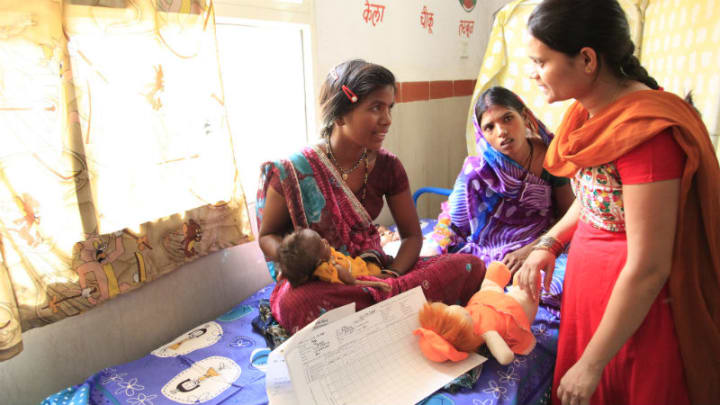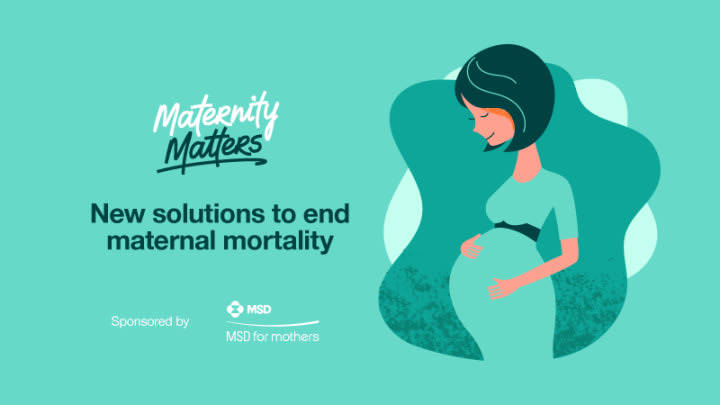
Despite remarkable gains in maternal and infant mortality rates over the past decades, we are still falling short on Sustainable Development Goal 3 — reducing global maternal mortality to less than 70 per 100,000 live births, and neonatal and under-5 mortality to at least as low as 12 and 25 per 1,000 live births, respectively. Nor are we where we need to be in terms of reproductive or adolescent health goals, such as ensuring universal access to health care.
One of the biggest barriers to achieving reproductive maternal newborn child and adolescent health, or RMNCAH, goals is sustainable financing.
“The best blended financing is about de-risking projects and markets that the private sector would not normally invest in but which ultimately become self-sustainable.”
— Paul Horrocks, head of private finance for sustainable development unit, OECDAccording to a report on the state of health care by Devex and MSD for Mothers, while international RMNCAH funding accounts for approximately half of total development assistance for global health, there is still a funding deficit of more than $30 billion.
The private sector has the potential to play a pivotal role in closing this gap — from reducing out-of-pocket costs for private services, to making medicines more affordable, to leveraging new funding tools.
Blended financing: Do the incentives line up?
This in-depth series explores how private sector approaches can help channel both the financial resources needed to end preventable maternal mortality and the knowledge and innovation needed to create sustainable solutions. Learn more about how cross-sectoral approaches can be scaled and replicated to improve maternal health outcomes.
One financing model that has been generating a lot of buzz in development circles is blended financing — a term defined by the Organisation for Economic Co-operation and Development as “the strategic use of development finance for the mobilization of additional commercial finance towards the SDGs in developing countries.” Often, this means using public finance to “de-risk” private investment with donor funding, thus encouraging private companies to contribute to development funding.
Paul Horrocks, head of the unit for private finance for sustainable development at OECD, believes that blended finance can be a potentially useful fundraising mechanism for health goals, so long as the projects are managed carefully.
“First of all, you have to identify and test the project to ensure that it will contribute to the public good, particularly in the health sector,” he said. “This is critical because blended finance is about growing the pie, and not about trying to privatize parts of the development environment that really should be funded by grants.”
But according to Polly Meeks, an independent analyst and author of a report on blended financing for NGO coalition Eurodad in 2017, the potential as a mechanism to successfully raise funding for health-related development goals is still largely unproven, and may even be problematic.
Thus far, Meeks said, most blended financing projects have focused on infrastructure — not health. She also found that projects funded through blended finance tend to be used more frequently in middle-income countries, may give preferential treatment to donors’ own private-sector firms, and are at risk of leaving behind the populations that are the most difficult to reach.
“There’s an opportunity cost,” explained Meeks. “When you use donor aid to subsidize a private investment, that’s one less dollar to go towards public sector programs. Plus, there isn’t a lot of compelling evidence on impact in the health space.”
According to Horrocks, it is vital to ensure that projects funded through blended finance mechanisms have clearly outlined goals and local ownership, strong government partners driving the projects, and that private sector incentives are taken into account from the very beginning.
Thus far, many successful blended finance projects have been related to infrastructure and climate change, he added, and fewer relate directly to health. This is in part due to the fact that most successful blended finance projects require a revenue link to incentivize private sector participation — which can be tricky when trying to apply blended finance models to sectors such as reproductive and maternal health, in which the most vulnerable often don’t have the resources to finance care.
“There’s a lot of opportunity where people can recognize the benefits of having access to health, but it’s really important to be clear about who you are targeting to make sure that the neediest parts of society end up being effectively targeted,” Horrocks said.
Lack of examples
Because of these challenges, there are fewer examples of successful blended finance programs in the health space that directly address RMNCAH. Those that do exist tend to have an indirect impact.
RMNCAH in context
Ensuring that every woman, child, and adolescent has access to the health care they need to stay healthy and thrive is vital in order to achieve the SDGs — particularly the targets of reducing poverty, economic inequality, and making universal health coverage a reality.
As an example, Horrocks pointed to a nutrition program in Rwanda that provides fortified nutrients to children. The project involved directed blended financing and concessional funding from the private sector window of the Global Agricultural and Food Security Program, a donor fund managed by the International Finance Corporation, to provide financing and training for 11 farmers’ cooperatives to boost maize and soy production, and build a food processing plant.
According to Horrocks, the project was successful in part because it aligned stakeholders’ incentives and resources toward a common goal, which also aligned with long-term country targets: creating more nutritional food for local distribution, while also boosting the local economy.
“Blended finance that directly targets RMNCAH is still in its infancy,” Horrocks said, though he added that there are many examples of blended finance that have an indirect positive impact on RMNACH — for example, programs that take wood-burning stoves out of people’s homes or ensure proper water filtration.
“The best blended financing is about de-risking projects and markets that the private sector would not normally invest in but which ultimately become self-sustainable,” he explained. “That’s what blended finance is about.”
Leveraging the private sector for those at the base of the pyramid
Another way the private sector can help with financing is by making medicines and care more affordable to those who need it most.
In Uganda, for example, approximately 70% of total health expenditures on maternal and reproductive health is paid for by women out of pocket — much of it to private sector providers.
This isn’t limited to Uganda: According to an analysis by the London School of Hygiene and Tropical Medicine examining where women receive maternal care across nearly 60 low- and middle-income countries, approximately 40% of women relied on private sector providers for maternity and family planning services.
This means that reducing the cost of privately provided maternal and reproductive services could make a big economic difference for those who need it most.
“Unfortunately, while the public sector is naturally networked, there’s a lot of fragmentation in the private sector in many low- and middle-income countries,” said Yasmin Madan, the private sector lead for ThinkWell, a health systems development organization focused on helping countries achieve universal health coverage.
“This can lead to a lot of variety in quality and cost.”
ThinkWell is in the preliminary process of researching the challenges facing private health providers — such as midwives — in the Philippines. It found that fragmentation also makes it more difficult for private-sector providers to be covered by public insurance schemes, which means that many women end up paying for care out of pocket.
The Philippine government recently passed a universal health care act. While midwives should in theory be able to be reimbursed for their services under this new health care scheme, confusion with the billing procedure as well as a lack of standardized accreditation and licensing practices mean that many aren’t able to access government financing.
“There’s a real need for intermediary models to support midwives and other private providers with registration, accreditation, and third-party payment processors,” Madan said. “This is an issue we see again and again with informal providers in the health care sector — like drug shops, pharmacies, midwives, etc. It’s a critical missing link.”
Other models making headway
Social franchising is another model that stakeholders are experimenting with to standardize the quality of care provided by health care workers in the maternal and reproductive health space while also addressing issues related to affordability and sustainability.
MSD for Mothers, in partnership with Population Services International, Programme for Accessible health Communication and Education, the Association of Obstetricians and Gynaecologists of Uganda and others, has adopted a social franchising program called MSD for Ugandan Mothers, or MUM, to improve the quality of care provided by midwives in rural Uganda.
In addition to providing training and equipment to midwives, the program works with local communities to make saving schemes available to women that can be used to pay for delivery services. Additionally, economic incentives for “bodaboda” drivers were created — privately-run motorcycle taxi services common to the area — to safely transport women to midwives for antenatal care and when it was time to deliver their babies.
According to Dr. Mariam Luyiga, who worked as a quality improvement specialist on the project, adopting a social franchising model was critical to ensuring sustainability as it provided opportunities for certification and regulation of quality in the private sector.
“When you adopt a social franchising model, you are able to have certification and accreditation systems which help providers maintain standards of care,” she explained. “That’s vital to ensure sustained quality — and once they’ve been accredited, and demand is generated, you can begin to find financing mechanisms."
While the private sector already plays a vital role in providing health services in the RMNCAH space, there is more that needs to be done in order to successfully bridge the funding gap. From experimenting with adapting new financial tools — such as blended finance — to adopting social financing and other models that make care more affordable to those who need it most, there are many ways to better engage stakeholders from the private sector to improve RMNCAH financing.
The Maternity Matters series is sponsored by MSD for Mothers, MSD’s $500 million initiative to help create a world where no woman has to die giving life. The content of this article is the responsibility of the author(s) and does not necessarily represent the official views of MSD. MSD for Mothers is an initiative of Merck & Co., Inc. Kenilworth, N.J., U.S.A.





